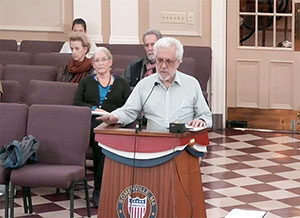
The public got its chance to weigh in on the matter of too many trees going away in recent years at a public hearing held last week by the Open Space, Environment and Energy Committee of the Board of Aldermen.
By Jim Clark
The Open Space, Environment and Energy Committee of the Somerville Board of Aldermen held a special public hearing in the City Hall Aldermanic Chambers of Wednesday, October 3, to update the public on matters related to the city’s Urban Forestry Plan, and to hear comments from the public on related matters.
Director of Transportation & Infrastructure Brad Rawinson, Vanessa Boukili, Ph.D, and Urban Forestry and Landscape Planner MCA prepared and presented a report covering details of the city’s Seven Year Action Plan targeting specific goals for the prescribed period.
After the presentation, members of the public were invited to share their ideas and ask questions of the Committee and their experts.
Comments and questions ranged from inquiries as to why so many trees had been removed from public spaces, especially in light of the city’s stated policy of developing its urban forest canopy rather than diminishing it.
The general response to this question involved a litany of factors, primarily involving a combination of construction development projects and the effects of GLX project activities.
In spite of this, the city reaffirmed its commitment to make up for these losses over the years to come.
The following are a sampling of comments offered by members of the public:
“The administration’s creation of an Urban Forestry Division is a good first step in this direction. I hope the administration and Board will provide that team with all the resources it needs to ensure the above. But at the same time, I hope the Board will subject any requests for mature tree removal to severe scrutiny. Any proposal to remove a mature tree needs to make a compelling argument as to why the value of that tree dead is greater than the value of leaving that tree alive and undisturbed.”
“In urban areas, trees are basically giant air purifiers. Urban air is full of toxic gases and particulate matter from car exhaust, home fuel use, dust, salt and industrial pollution. Trees effectively remove much of this pollution, either by accumulating it on their surfaces or absorbing it in through their leaves. A 2006 study looked at air pollution reduction by urban trees and estimated that in the Boston area alone trees save $1.47 million per year through removing
ozone, particulate matter, sulfur dioxide, nitrogen dioxide and carbon monoxide. David Nowak and colleagues went even further in their 2014 study, where they estimated that air pollution removal by urban trees saves not only dollars but also lives. They calculated that urban trees prevent more than 850 deaths and 670,000 incidences of acute respiratory problems annually in the U.S. While the pollen of some tree species can exacerbate seasonal allergies, these are a subset of common urban tree species and are often non-native and/or wind-pollinated. With some thoughtful consideration to the natural history of the species used, urban trees can have an overall strongly positive affect on air quality and respiratory health.”
“The recent destruction of trees throughout Somerville is extremely concerning. One can’t easily assign a dollar value to a tree, but it’s well known that a healthy urban tree canopy is vital to both the environmental and emotional well-being of the city and its inhabitants, even more so in Somerville, given how little green space we have in our small and densely built-up city.”
The Committee thanked the members of the public for their input and assured them that they would be working diligently to preserve and protect the city’s greenery to the utmost of their ability.


















Reader Comments